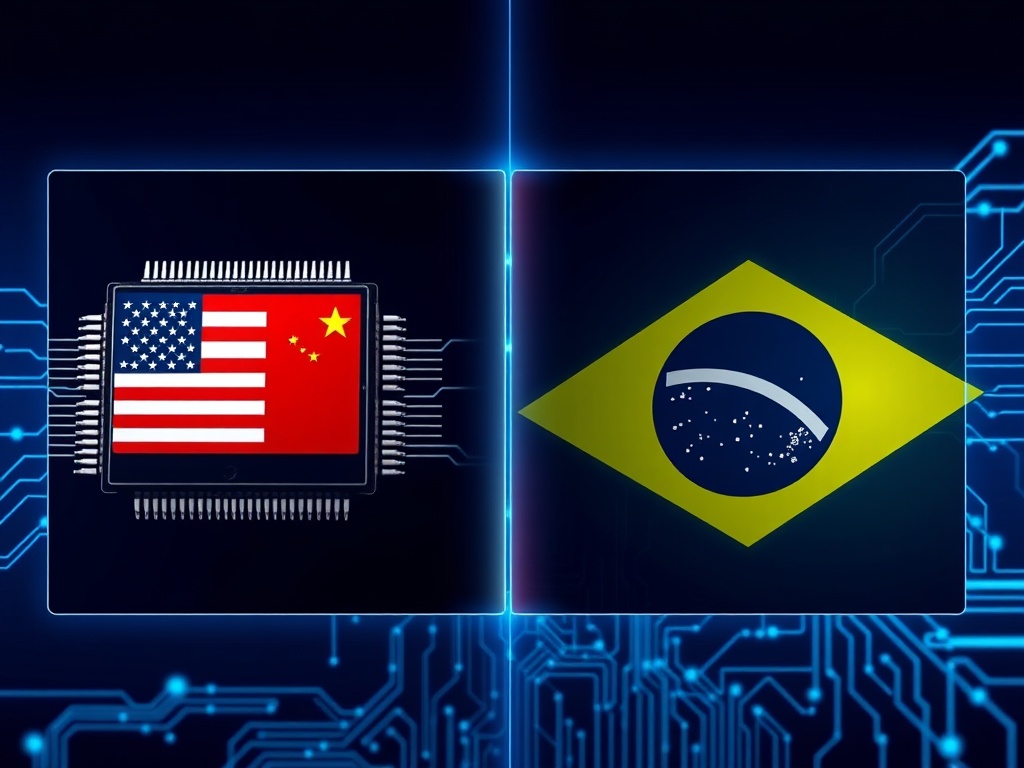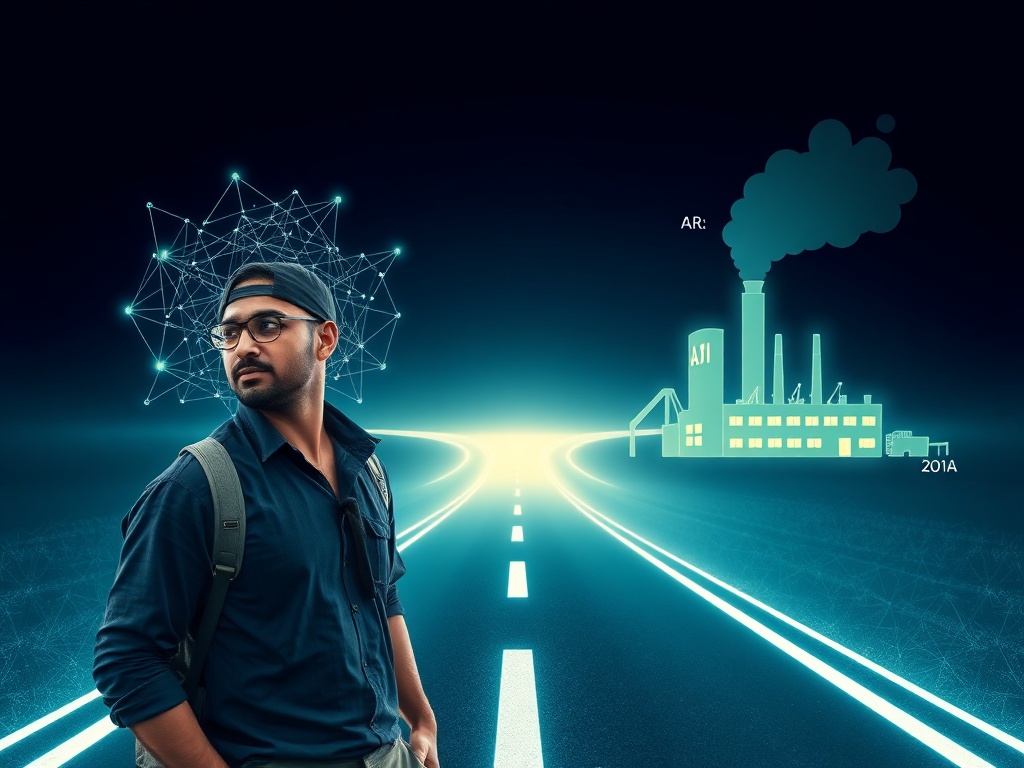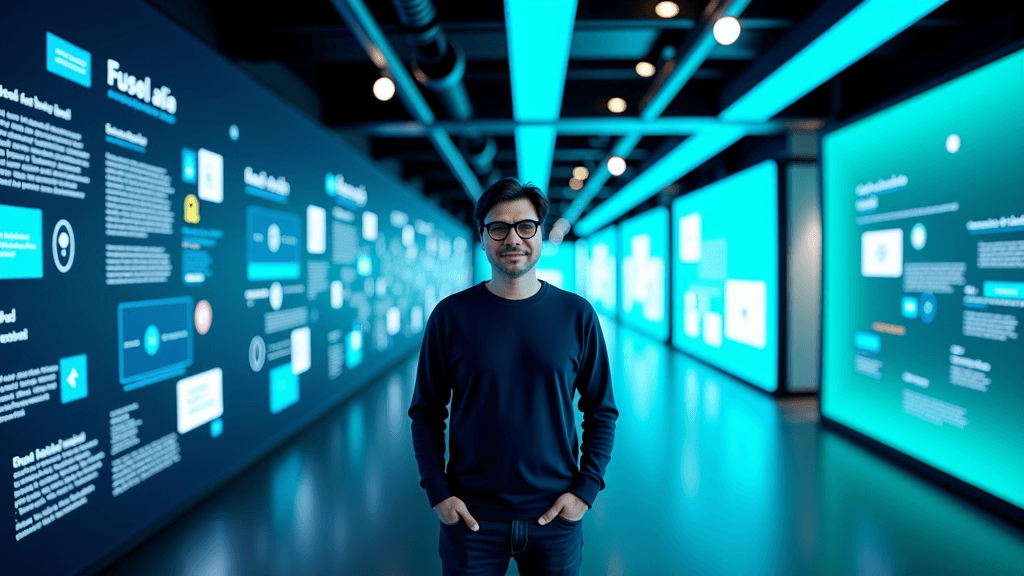All blog posts
Insights on startups, AI, innovation, the future of work and technology education. Practical strategies for impact businesses and digital transformation.
Enquanto Donald Trump anuncia uma reviravolta histórica ao autorizar a venda de chips avançados de IA para a China (mediante 25% de participação nas vendas), o Brasil está prestes a se tornar o país mais restritivo do mundo em relação ao treinamento de inteligência artificial. Se isso não soa como a definição perfeita de um momento crítico no xadrez geopolítico da IA, eu não sei o que é.
As últimas 24 horas trouxeram notícias que, colocadas lado a lado, revelam um cenário fascinante: enquanto grandes potências negociam bilhões em semicondutores e regulamentações nacionais centralizadas, o Brasil debate quem deve pagar pelo uso de obras protegidas por direitos autorais no treinamento de modelos. E não, essa não é uma questão menor — mas o timing e o contexto nos mostram algo profundo sobre onde estamos na corrida global pela inteligência artificial.
Vamos mergulhar nos fatos, analisar as implicações e entender o que isso significa para quem trabalha com IA, empresas e, claro, para o futuro do ecossistema brasileiro de inovação.
Trump Reverte Política de Biden e Libera Chips H200 da Nvidia Para China
Começando pelo que movimentou o mercado global: Donald Trump anunciou que autorizará a Nvidia a exportar semicondutores avançados de inteligência artificial (especificamente o GPU H200) para a China, sob algumas restrições de segurança nacional.
A condição? Os Estados Unidos receberão 25% sobre essas vendas.
Essa decisão reverte diretamente as restrições impostas pelo governo Biden, que forçavam empresas americanas a criar produtos “degradados” para o mercado chinês. Trump comunicou pessoalmente a Xi Jinping sobre a mudança, sinalizando uma nova fase nas relações comerciais sino-americanas — pelo menos no front da tecnologia.
Mas atenção: os chips mais avançados (das séries Blackwell e Rubin) permanecem restritos exclusivamente a clientes americanos. Ou seja, a liberação é estratégica, não irrestrita.
O Que Isso Significa na Prática?
Primeiro, temos que entender o contexto: a Nvidia estimava um mercado chinês de aproximadamente US$ 50 bilhões. Não estamos falando de trocados — estamos falando de um mercado que literalmente define a viabilidade financeira de gerações inteiras de semicondutores.
Trump argumenta que a medida visa “proteger a Segurança Nacional, criar empregos americanos e manter a liderança dos EUA em IA”. Ele chegou a afirmar que as restrições anteriores prejudicavam empresas como a Nvidia, colocando-as em desvantagem competitiva global.
Jensen Huang, CEO da Nvidia, fazia lobby intenso pela reversão das restrições — e claramente conseguiu o que queria.
Mas há uma tensão aqui: a senadora Elizabeth Warren alertou publicamente que essa flexibilização “turbinaria o poder militar chinês”. E ela não está errada. Semicondutores avançados não servem apenas para treinar chatbots — eles são a base de sistemas de defesa, vigilância e, sim, armamentos autônomos.
Estamos literalmente vendo em tempo real a dança geopolítica entre interesses comerciais versus segurança nacional versus liderança tecnológica. E o Brasil? Bom, vamos chegar lá.
Trump Também Anuncia Regulamentação Federal Única Para IA nos EUA
Como se a liberação dos chips não fosse suficiente, Trump anunciou que assinará uma ordem executiva ainda esta semana para criar uma regulamentação nacional única sobre inteligência artificial nos EUA, invalidando todas as normativas estaduais.
A justificativa é direta: ele considera que 50 aprovações estaduais diferentes travarão o setor e comprometeram a liderança americana na corrida global pela IA. Trump foi enfático: “A IA será destruída no seu início” se as empresas precisarem navegar por um emaranhado burocrático de regras estaduais.
Essa decisão confronta diretamente estados como a Califórnia e procuradores de 36 estados que defendem a agilidade dos governos estaduais para responder à rápida evolução da tecnologia.
Por Que Isso Importa?
Porque centralização regulatória é uma aposta de mão dupla. Por um lado, pode realmente acelerar a inovação ao eliminar fragmentação. Por outro, pode criar um vácuo de proteção em questões regionais sensíveis — pense em privacidade de dados, direitos trabalhistas locais ou especificidades culturais.
O que me chama atenção aqui não é apenas a decisão em si, mas o discurso subjacente: Trump está posicionando a IA como uma questão de “domínio mundial” e segurança nacional. Isso não é retórica vazia — é estratégia de Estado.
E enquanto isso, no Brasil…
O Dilema Brasileiro: R$ 21 Bilhões em Risco Por Questões de Direitos Autorais
Agora chegamos ao coração do debate nacional. Segundo análise publicada pela UOL, o Brasil está caminhando para ser o país mais restritivo do mundo em relação ao treinamento de IA, o que pode resultar na perda de R$ 21 bilhões para o PIB nacional caso a legislação proíba o uso de obras protegidas por direitos autorais para treinar IAs generativas.
Vamos destrinchar isso, porque é complexo e importante.
A Questão de Fundo
Treinar modelos de linguagem grandes (LLMs) exige acesso a volumes massivos de dados — textos, imagens, vídeos, código. Grande parte desse material está protegido por direitos autorais. A pergunta é: quem deve pagar pelo uso dessas obras no treinamento?
A proposta legislativa em debate no Brasil é vista por muitos como extremamente restritiva, potencialmente levando empresas a transferirem seus data centers para outras jurisdições — países com regulamentações mais amigáveis ou, no mínimo, mais claras.
O problema não é apenas financeiro. É estrutural. Se o Brasil se tornar incompatível com o treinamento de modelos de IA, não estamos falando apenas de perda de receita — estamos falando de dependência tecnológica permanente.
A Disputa Real: Big Techs vs. Detentores de Direitos
Como bem colocado na reportagem, essa questão é, na prática, uma disputa entre grandes conglomerados: quem treina modelos de IA (Google, Meta, OpenAI) versus quem detém direitos autorais (editoras, produtoras, artistas organizados).
E adivinha quem pode acabar se beneficiando de uma regulação ultra-restritiva no Brasil? Exatamente as big techs americanas que já têm modelos prontos, treinados em jurisdições permissivas.
Se startups brasileiras e projetos de pesquisa forem barrados de treinar modelos localmente com dados nacionais, estaremos efetivamente entregando de bandeja o mercado para players internacionais — que, ironicamente, já usaram (e continuam usando) dados brasileiros disponíveis na internet aberta.
Soluções Possíveis
A reportagem sugere um caminho intermediário: combinar remuneração com flexibilidade. Cobrar taxas das big techs que lucram com IA generativa, enquanto startups e projetos de pesquisa teriam modelos mais flexíveis ou isenções.
Ferramentas como a ProRata.AI são citadas como exemplos de tecnologia que pode rastrear quais obras foram usadas no treinamento, possibilitando remunerações transparentes e justas.
Mas implementar isso exige sofisticação regulatória, vontade política e, principalmente, velocidade — algo que nem sempre vemos nos processos legislativos brasileiros.
Contexto Geopolítico: China Lança Qwen e Atinge 10 Milhões de Downloads
Para completar o cenário das últimas 24 horas, temos a China lançando o Qwen (da Alibaba), que alcançou 10 milhões de downloads em apenas uma semana, competindo diretamente com Gemini, ChatGPT e o próprio DeepSeek.
Isso reforça um ponto que venho repetindo: a corrida da IA não é binária (EUA vs. China). Ela é multipolar, rápida e implacável. Modelos surgem, evoluem e saturam mercados em questão de semanas.
Enquanto isso, regulamentações levam anos para serem aprovadas.
Outras Notícias Relevantes das Últimas 24 Horas
Trabalhadores que Treinam IA Alertam Familiares Para Não Usá-la
Uma reportagem impactante da ICL Notícias revelou que trabalhadores que treinam sistemas como ChatGPT, Gemini e Grok estão alertando familiares para não usarem essas ferramentas.
Por quê? Porque eles percebem diariamente a facilidade com que conteúdos racistas, desinformação e respostas perigosas passam pelos filtros. Eles também relatam falta de treinamento especializado para avaliações sensíveis.
Dados alarmantes:
- Chatbots reduziram as respostas “não sei” de 31% para 0% entre 2024 e 2025
- Essa redução dobrou a reprodução de desinformação
- A OpenAI enfrenta processo pela morte de um adolescente que conversava com o ChatGPT, que a família alega ter fornecido instruções suicidas
Isso nos lembra que por trás de toda interface amigável e resposta fluente, há fragilidade técnica e decisões de produto que priorizam crescimento sobre segurança.
Indústria Musical: IA Gera 34% das Faixas Recebidas Diariamente
THE Business Season reportou que o Deezer recebe diariamente mais de 50.000 faixas geradas por IA — mais de 34% do total.
E aqui está o dado assustador: uma pesquisa Deezer/Ipsos com 9 mil pessoas mostrou que 97% erraram ao tentar diferenciar músicas geradas por IA de músicas criadas por humanos.
O produtor Rick Bonadio foi direto: música feita por IA não é arte. Mas a realidade é que consumidores não conseguem distinguir — e isso muda tudo.
O lado bom? 76% dos brasileiros querem transparência sobre conteúdo de IA, e 65% acreditam que a IA ameaça a remuneração de músicos, pedindo proteção aos direitos autorais.
Imagem Falsa de IA Cancela Trens na Inglaterra
E para mostrar que os riscos da IA generativa não são apenas teóricos, a BBC reportou que uma imagem falsa gerada por IA levou ao cancelamento de trens por uma hora e meia no noroeste da Inglaterra.
A imagem mostrava a ponte Carlisle parcialmente destruída após um tremor de 3,3 de magnitude. A Network Rail interrompeu os serviços para inspeção de segurança, resultando em 32 serviços atrasados e custos significativos para o contribuinte.
O especialista Tony Miles observou que o maior problema não foi o atraso em si, mas a mobilização desnecessária de equipes de checagem, que pode gerar impactos por dias.
O Que Esses Fatos, Juntos, Revelam?
Quando olhamos para as últimas 24 horas como um todo, três padrões emergem com clareza:
1. Soberania Tecnológica É Questão de Segurança Nacional
Trump está tratando IA como prioridade estratégica de Estado — centralizando regulação, negociando exportações bilionárias com condições favoráveis aos EUA, e posicionando a tecnologia como questão de “domínio mundial”.
A China, por sua vez, continua lançando modelos competitivos globalmente, contornando sanções e investindo pesadamente em infraestrutura.
E o Brasil? Está debatendo direitos autorais — o que é importante, mas não pode ser a única pauta estratégica.
2. A Fragmentação Regulatória É Um Risco Real
Trump tem um ponto (mesmo que controverso): 50 regulamentações estaduais diferentes podem realmente travar o setor. Isso não significa que centralização autoritária é a resposta, mas clareza, previsibilidade e harmonização são urgentes.
No Brasil, precisamos de um marco regulatório que proteja direitos sem inviabilizar inovação. E precisamos disso now — não em três anos.
3. Confiança é o Ativo Mais Escasso
Trabalhadores que treinam IA alertando familiares para não usá-la. Músicos vendo 34% do mercado inundado por conteúdo sintético indistinguível. Trens sendo cancelados por imagens falsas.
A tecnologia avançou mais rápido que nossa capacidade de avaliar, auditar e confiar nela. E confiança não escala automaticamente com capacidade computacional.
O Que Isso Significa Para Empresas e Profissionais Brasileiros?
Se você trabalha com IA, lidera projetos de transformação digital ou simplesmente tenta entender como sua empresa deve se posicionar nesse cenário, aqui vão algumas reflexões práticas:
Para Empresas
- Atenção à regulação em curso: Se você planeja treinar modelos proprietários com dados brasileiros, acompanhe de perto as discussões legislativas sobre direitos autorais e TDM (Text and Data Mining)
- Considere parcerias transparentes: Ferramentas como ProRata.AI e modelos de licenciamento claro podem ser diferenciais competitivos
- Diversifique fornecedores: Não dependa exclusivamente de um único provedor de IA generativa — especialmente se ele estiver sujeito a restrições geopolíticas
- Invista em governança: Ter processos claros de auditoria, explicabilidade e segurança não é mais opcional — é requisito mínimo
Para Profissionais
- Desenvolva senso crítico técnico: Saber usar ChatGPT é diferente de entender suas limitações, vieses e riscos
- Especialize-se em nichos regulados: Áreas como saúde, jurídico e financeiro exigirão IA com compliance específico — seja a pessoa que entende disso
- Conecte tecnologia com impacto: Os projetos de IA de maior valor agregado nos próximos anos serão aqueles que resolvem problemas reais com responsabilidade
Minha Visão: Precisamos de Pragmatismo Estratégico
Trabalho com governos, empresas e ecossistemas de inovação há anos, e posso dizer com segurança: o Brasil não pode se dar ao luxo de ser o país mais restritivo do mundo em IA.
Isso não significa abrir mão de direitos autorais, privacidade ou segurança. Significa ser estratégico, pragmático e rápido.
Precisamos de uma regulação que:
- Proteja criadores brasileiros sem inviabilizar startups nacionais
- Permita experimentação responsável em ambientes controlados (sandboxes regulatórios)
- Incentive infraestrutura local (data centers, GPUs, talentos)
- Estabeleça transparência obrigatória sobre dados de treinamento e modelos
- Crie mecanismos de remuneração justos e tecnicamente viáveis
E, acima de tudo, precisamos de velocidade. Enquanto os EUA centralizam regulação e negociam bilhões com a China, e a China lança modelos que atingem 10 milhões de usuários em uma semana, o Brasil não pode ficar anos debatendo a mesma lei.
Conclusão: A Janela de Oportunidade Está se Fechando
As últimas 24 horas nos mostraram que a corrida pela IA não é apenas tecnológica — é geopolítica, regulatória e, fundamentalmente, sobre quem terá soberania para decidir seu próprio futuro digital.
O Brasil tem talento, mercado e potencial. Mas talento sem infraestrutura não escala. Mercado sem clareza regulatória não atrai investimento. E potencial sem estratégia não se realiza.
Não estou pedindo que copiemos Trump ou Xi Jinping. Estou pedindo que tenhamos a coragem de ser pragmáticos, a velocidade de ser relevantes e a sabedoria de ser inclusivos.
Porque se perdermos essa janela — e ela está se fechando — não estaremos apenas perdendo R$ 21 bilhões. Estaremos perdendo uma geração inteira de capacidade tecnológica.
No meu trabalho de mentoring e consultoria, ajudo executivos, empresas e governos a navegarem exatamente por essas encruzilhadas estratégicas — onde tecnologia, regulação e impacto se encontram. Se sua organização está tentando entender como se posicionar nesse cenário em rápida transformação, vamos conversar. Porque as decisões que tomamos hoje definirão se seremos protagonistas ou espectadores da era da inteligência artificial.
E eu não sei você, mas eu prefiro protagonismo.










